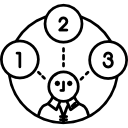Cryptographic hash: Difference between revisions
Mr. MacKenty (talk | contribs) (Created page with "<center> <blockquote style="padding: 5px; background-color: #FFF8DC; border: solid thin gray;"> File:Exclamation.png This is student work which has not yet been approve...") |
Mr. MacKenty (talk | contribs) No edit summary |
||
| (3 intermediate revisions by the same user not shown) | |||
| Line 1: | Line 1: | ||
[[file:computation.png|right|frame|Computational thinking, problem-solving and programming<ref>http://www.flaticon.com/</ref>]] | |||
</ | |||
</ | |||
[[ | Prior to reading this article, you should understand [[Hashing|hashing]]. | ||
A cryptographic hash function (CHF) is a hash function that is suitable for use in cryptography. It is a mathematical algorithm that maps data of arbitrary size (often called the "message") to a bit string of a fixed size (the "hash value", "hash", or "message digest") and is a one-way function, that is, a function which is practically infeasible to invert. Ideally, the only way to find a message that produces a given hash is to attempt a brute-force search of possible inputs to see if they produce a match, or use a rainbow table of matched hashes. Cryptographic hash functions are a basic tool of modern cryptography.<ref>https://en.wikipedia.org/wiki/Cryptographic_hash_function</ref> | |||
The ideal cryptographic hash function has the following main properties: | |||
* it is deterministic, meaning that the same message always results in the same hash | |||
* it is quick to compute the hash value for any given message | |||
* it is infeasible to generate a message that yields a given hash value | |||
* it is infeasible to find two different messages with the same hash value | |||
* a small change to a message should change the hash value so extensively that the new hash value appears uncorrelated with the old hash value (avalanche effect) | |||
== | == Video == | ||
<html> | |||
<iframe width="560" height="315" src="https://www.youtube.com/embed/UswqcbncliE" frameborder="0" allow="accelerometer; autoplay; encrypted-media; gyroscope; picture-in-picture" allowfullscreen></iframe> | |||
</html> | |||
== | |||
== References == | == References == | ||
<references /> | |||
[[Category: | [[Category:programming]] | ||
Latest revision as of 18:57, 8 March 2020

Prior to reading this article, you should understand hashing.
A cryptographic hash function (CHF) is a hash function that is suitable for use in cryptography. It is a mathematical algorithm that maps data of arbitrary size (often called the "message") to a bit string of a fixed size (the "hash value", "hash", or "message digest") and is a one-way function, that is, a function which is practically infeasible to invert. Ideally, the only way to find a message that produces a given hash is to attempt a brute-force search of possible inputs to see if they produce a match, or use a rainbow table of matched hashes. Cryptographic hash functions are a basic tool of modern cryptography.[2]
The ideal cryptographic hash function has the following main properties:
- it is deterministic, meaning that the same message always results in the same hash
- it is quick to compute the hash value for any given message
- it is infeasible to generate a message that yields a given hash value
- it is infeasible to find two different messages with the same hash value
- a small change to a message should change the hash value so extensively that the new hash value appears uncorrelated with the old hash value (avalanche effect)
Video